Abstract
Safety risk assessment is essential in ensuring the smooth construction of undersea tunnels. Obtaining reasonable safety risk assessment results requires multi-source information that enjoys static and dynamic attributes. However, acquiring and utilizing such uncertain information creates difficulties in the decision-making process. Therefore, this paper proposes a safety risk assessment approach based on building information modeling (BIM), intuitionistic fuzzy set (IFS) theory, and Dempster–Shafer (D-S) evidence theory. Firstly, an undersea tunnel construction collapse risk evaluation index system is established to clarify the information requirements of the pre-construction and construction stages. The semantic information of the BIM geometric model is then enriched through industry foundation classes (IFC) extension to match the multi-criteria decision-making (MCDM) process, with BIM technology used to assist in information acquisition and risk visualization. Finally, based on the intuitionistic fuzzy D-S evidence theory, multi-information fusion is performed to dynamically determine safety risk levels. Specifically, IFS theory is utilized for basic probability assignments (BPAs) determination before applying D-S evidence theory. The conflicting evidence is dealt with by reliability calculation based on the normalized Hamming distance between pairs of IFSs, while safety risk levels are accomplished with score functions of intuitionistic fuzzy values (IFVs). The proposed method is applied to collapse risk assessment in the karst developed area of a shield tunnel construction project in Dalian, China, and the feasibility and effectiveness are verified. The novelty of the proposed method lies in: (1) information collaboration between the BIM model and the dynamic safety risk assessment process being realized through IFC-based semantic enrichment and Dynamo programming to enhance the decision-making process and (2) the introduction of IFS theory to improve the applicability of D-S evidence theory in expressing fuzziness and hesitation during multi-information fusion. With the proposed method, dynamic safety risk assessment of undersea tunnel construction projects can be performed under uncertainty, fuzziness, and a conflicting environment, while the safety risk perception can be enhanced through visualization.
1. Introduction
With the increasing demand for urban residents’ travel convenience, undersea tunnel construction projects have been developed over the years. Due to the complex geological and hydrological environments of passing through the crushed zones or karst development areas, accidents such as water leakage and collapse tend to occur, leading to delays, economic losses, and even casualties [1]. The shield method is a commonly used construction method for undersea tunnels. Influenced by soil movement, changes in water pressure, and the vibration of construction machines, the status of the lining structure enjoys dynamic characteristics during excavation [2]. Therefore, it is necessary to perform a real-time and proactive safety risk assessment during the construction process and implement control measures in time to prevent accidents.
Most of the existing safety risk assessment methods rely on only certain types of information, such as field experience, lab experiments, or sensor monitoring data [3]. However, single-source information is often one-sided and may be inaccurate due to subjective or objective reasons. For instance, cognitive uncertainty lies in the expert decision-making process, information derived from geological exploration reports is limited by the location and number of boreholes, and sensor failure may lead to unreliable monitoring data. Therefore, when performing a dynamic safety risk assessment for tunnel construction projects, it is necessary to apply and integrate multi-source information with dynamic attributes to obtain more reasonable results [4]. This is a multi-criteria decision-making (MCDM) process. However, it is challenging for decision-makers to obtain and utilize comprehensive information according to requirements due to its various storage modes [5], while uncertainty lies in the inconsistency of index values and the fuzziness of expert judgments brings ambiguity to the results. Moreover, the gap between risk information and physical structure hinders the rapidity and effectiveness of decision-making.
To bridge the gaps, this paper proposes a dynamic safety risk assessment method for undersea tunnel construction projects based on building information modeling (BIM) and intuitionistic fuzzy Dempster–Shafer (D-S) evidence theory. BIM technology is applied to realize the uniform description and acquisition of both dynamic and static information as well as visualization for better risk perception. Intuitionistic fuzzy set (IFS) theory is combined with D-S evidence theory for basic probability assignments (BPAs) determination of evidence under various criteria, with the conflict of evidence dealt with by distance calculations between IFSs. In cooperating with the evidence updating rule, multi-source information fusion and safety risk assessment in uncertain, conflicting, and dynamic environments are then realized. The rest of the paper is organized as follows: Section 2 is a literature review. Section 3 presents some concepts and theoretical foundations of IFS and D-S evidence theory. Section 4 introduces the safety risk assessment approach proposed in this paper. Section 5 presents the safety risk assessment of an undersea shield tunnel construction project in China to demonstrate the applicability of the developed approach. Section 6 is a discussion of the results. Section 7 presents the conclusions and proposes future works.
2. Literature Review
Megaprojects such as undersea tunnel projects are essential and significantly impact the community and economy [6]. The success of the construction process largely depends on efficient and reasonable safety risk assessment, during which two issues need to be clarified: (1) the efficient acquisition of information and (2) the effective utilization of multi-information acquired. As for the first issue, the quantity and quality of information are critical influencing factors [7]. In recent years, the increasing use of BIM technology in construction projects improved the safety risk management process [8]. BIM models are digital representations of the physical world that follow industry foundation classes (IFC) standards, which make it possible to store multi-source information in a structured form [9]. As a carrier of information, BIM plays a vital role in the MCDM process and its leading roles are storing information as a database, collecting and analyzing data as a processing tool, and implementing information exchanges as an intermediary. BIM-aided MCDM has been applied in multiple stages of the construction project life cycle, including compliance inspection, building renovation evaluation, and fire risk assessment [10,11,12]. Research has also combined BIM with various traditional methods to solve MCDM problems, such as the analytical hierarchical process (AHP), fuzzy set theory, and TOPSIS [13,14,15]. BIM technology not only provides abundant information but also feedback evaluation results to decision-makers in a visual form with the interaction between the MCDM process and BIM models for better risk perception [16].
One way to maximize the BIM technology assistance role is to improve the information richness and make BIM models consistent with the MCDM process [9]. During the safety risk assessment of tunnel construction projects, dynamic monitoring data serves as an essential information source for decision-making [17]. The tunnel construction BIM models not only contain information from the design stage but also monitoring data that can be dynamically supplemented in the form of attribute information during excavation. Applying BIM technology could achieve uniform access to multi-source information, enhance risk perception in a visual format, and help safety risk managers implement timely control measures for risk prevention. Researchers have already made efforts in such issues. For example, Guo et al. used the application programming interface (API) to extract information from BIM models, realizing the risk assessment of underground tunnels [18]. Zhou et al. established a 4M1E (man, machine, material, method, and environment) risk management system, dynamically collecting construction information through the BIM module to perform tunnel safety risk assessment [2]. However, most of the BIM-aided MCDM processes are accomplished in static environments or only use dynamic information to make decisions, but the knowledge of dynamic information structured representation in BIM models during tunnel construction safety risk assessment is still lacking.
Despite the acquisition of abundant information, how to use this information for rational decision-making is another crucial step. Various information fusion methods have been developed, including D-S evidence theory, rough set theory, maximum entropy approach, etc. Among them, D-S evidence theory has the advantage of dealing with uncertain and imprecise information and is one of the most promising methods [16]. It has been widely used in fields such as risk assessment, fault diagnosis, system health assessment, and wireless sensor networks [19]. D-S evidence theory can deal with uncertainty by assigning certain beliefs to imprecise information [20]. The practical application of D-S evidence theory in information fusion greatly depends on the accuracy of BPAs determination. The cloud model, the extension theory, the fuzzy matter element (FME) theory, and the fuzzy theory are mainly used methods for BPAs calculation [3,16,21]. The reasonable construction of the boundaries of different criteria is based on expert experience or sampling data. When the amount of data is limited, expert experience is greatly depended on and thus ambiguity exists. Fuzzy set theory can better fit such a circumstance since it can not only realize the mutual transformation between qualitative concepts and quantitative values, but also express the degree of belonging between elements and sets with the concept of membership, as well as reduce the impact of fuzziness. Research has looked at the advantages of both fuzzy set theory and D-S evidence theory in multi-information fusion. For instance, Ding et al. combined triangular fuzzy set theory and D-S evidence theory, using likelihood to calculate BPAs of monitoring data and deduce equipment conditions [22]. Ma et al. used triangular fuzzy numbers to construct the target model for generating BPAs [23]. Xia et al. applied the similarity between trapezoidal fuzzy numbers to measure the support degree of risk factors for different risk levels, and used D-S evidence theory to integrate multi-source information to realize risk assessment of deep-buried tunnels [24]. Besides fuzziness existing in BPAs calculation among multi-criteria, there is also hesitation involved in the belief determination of specific criteria, but it has not been fully taken into consideration. As a branch of fuzzy set theory, IFS theory can express not only membership information but also non-membership and hesitation, which is more suitable for dealing with uncertain issues [25].
Conflicting evidence is another issue that hinders the accuracy of multi-information fusion results. There are two ways to deal with this situation: modify the fusion rules or pre-process the raw evidence data acquired [19]. The idea of the latter option, to allocate greater weight to the more reliable evidence, is more commonly used. For example, Murphy found that the evidence information should be averaged so that not only all pieces of evidence are considered but the belief in the main evidence is increased [26]. Xiao comprehensively considered the belief entropy and the belief divergence between pieces of evidence for BPAs determination [27]. Although there is much mature research in this field, calculation rules of the mutual support degree of evidence are still mostly rely on the distance of crisp numbers but rarely consider the conflict represented in fuzzy forms.
Therefore, to bridge the gaps, this paper aims to build information-enriched BIM models through IFC extension and use Dynamo programming to dynamically add monitoring data to match the information requirements of the MCDM process. IFS theory is then combined with D-S evidence theories to express fuzziness and hesitation for more reasonable decision-making in the actual world.
3. Preliminaries
3.1. IFS Theory
IFS theory was proposed by Atanassov in 1986 [28]. The IFS theory extended the description of the fuzzy set to membership function, non-membership function, and hesitation function, and provided a more suitable description for uncertain information in an objective environment. The following are basic definitions of IFS theory:
- Definition 1
Let E be a fixed set, where , then A is called an IFS. The membership function of any x is and the non-membership function is , which satisfies . The hesitation function is defined as . Especially if , then A reduces to a fuzzy set.
If A is determined, then for each , its corresponding intuitionistic fuzzy value (IFV) can be abbreviated as and is a fundamental part of IFS [29]. For example, when the IFV of decision-making is (0.8, 0.1), it means that there is an 80% probability to support, 10% probability to oppose, and 10% probability representing hesitation in judgment.
- Definition 2
Suppose and are two IFVs in IFS A, then, the calculation algorithms between the two IFVs are given by:
- (1)
- (2)
- (3)
- (4)
- Definition 3
Let and be two IFSs, then the normalized Hamming distance between them is defined by [30]:
- Definition 4
Let be an IFV, then the score function of is and is defined as [31]:
The score function can be used to compare two IFVs. The larger the score function, the larger the IFV.
3.2. D-S Evidence Theory
D-S evidence theory, which is an approach to solving problems in uncertain environments and belongs to the category of artificial intelligence, was proposed by Dempster [32] and further improved by Shafer [33]. D-S evidence theory is a generalization of Bayes probability theory, which requires less prior knowledge during decision-making and is therefore more flexible. It can achieve multi-information fusion by assigning the probabilities of different evidence to a set of sub-criteria and then combining them. The basic definitions are as follows:
- Definition 5
Let be a set of mutually exclusive and collectively exhaustive events, indicated by , then is a frame of discernment. The set of its power sets is indicated by , where . If , then is a hypothesis.
- Definition 6
For a frame of discernment , a mass function is a mapping from to , defined as , which satisfies:
where is an empty set and is the mass function of . It is also called a BPA, reflecting the level of belief in a hypothesis .
- Definition 7
For a hypothesis with , the belief function is defined as:
The plausibility function is defined as:
where , and and represent the lower and upper bound functions of , respectively, satisfying . The belief function and plausibility function represent pessimistic and optimistic estimates, respectively, of the confidence degree in a hypothesis.
- Definition 8
Let and be two independent BPAs on the frame of discernment , then and can be fused based on Dempster’s rule of combination, defined as:
where and are elements of and is the coefficient of conflict between and , satisfying .
4. The Proposed Safety Risk Assessment Method
The proposed safety risk assessment method for undersea tunnel construction based on BIM and intuitionistic fuzzy D-S evidence theory is divided into four stages, as shown in Figure 1.
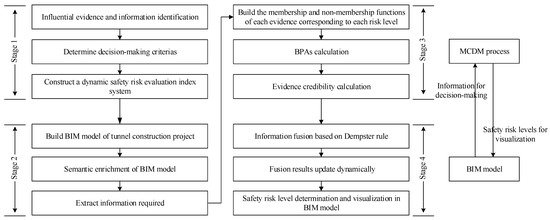
Figure 1.
The flow chart of the proposed safety risk assessment method.
The four-stage flow chart is established to realize information collaboration between the BIM model and the MCDM process. Firstly, Stage 1 aims to establish a safety risk evaluation index system. The required information then serves as a guide for building semantic-enriched BIM models in Stage 2. Stage 3 is the preparatory stage for information fusion, with the information extracted from BIM models. Finally, Stage 4 fuses the evidence information and updates it dynamically, determining and visualizing the safety risk levels in BIM models. In the proposed approach, the BIM model is used to provide the information required for decision-making dynamically, with the MCDM process results fed back to enhance risk perception using BIM technology.
4.1. Establishment of Tunnel Collapse Risk Evaluation Index System
The geological and hydrological conditions of undersea tunnels are complex and under huge safety risks, with karst development a commonly unfavorable geological condition [34]. Collapse is one possible safety risk accident in undersea tunnel construction projects passing through karst developed areas, and it has been one of the most notable problems and has attracted widespread attention. Thus, the following studies are undertaken with collapse risk as the research object to make the research more targeted. The two main risk factors for collapse accidents come from geological conditions and construction factors [35]. This paper constructs an evaluation index system for collapse risk assessment of undersea tunnel construction projects in karst developed areas, referring to the existing literature [1,4,18,34,35]. Most of the current index systems are static; however, taking the karst developed area as an example, the geological conditions before construction may be in a stable state, but with shield machine tunneling, the soil properties and hydrodynamics will change by construction disturbance, which is likely to lead to collapse accidents [36]. Moreover, information about the geological conditions, such as rock properties, is often obtained by a sampling inspection at the pre-construction stage, as it is difficult to obtain the disturbed and updated data during construction. Under these circumstances, a new evaluation index system is established in this paper and is divided into two parts: before construction and during construction, as shown in Figure 2.
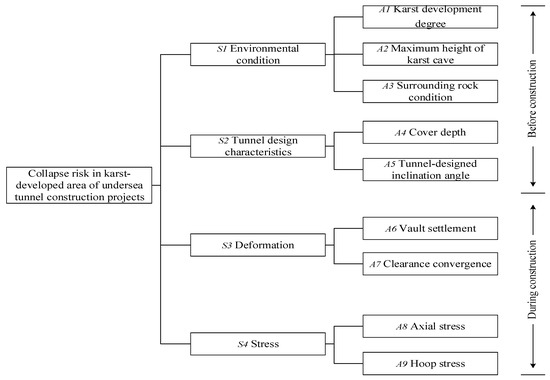
Figure 2.
The tunnel collapse risk evaluation index system in the karst developed area.
- (1)
- Evaluation index system of collapse risk before construction
The information for collapse risk assessment before construction comes from geological survey reports and design documents. The geological and construction factors on the collapse risk of the tunnel are reflected by environmental conditions and tunnel design characteristics, respectively. The constructed evaluation index system is shown in Figure 2, with two first-level indicators and five second-level indicators, and the details are as follows:
Environmental condition:
Karst development degree: Use the percentage of boreholes in which karst is encountered to reflect the development degree of karst in the assessment region [37], which is defined as Equation (7):
In Equation (7), is the number of geological exploration boreholes where karst caves are encountered and is the total number of boreholes in the assessment area. For example, if PBK = 80%, it means that 8 out of 10 boreholes drilled encountered karst development. The higher the regional karst development level, the more unstable the geological condition is and the more prone it is to collapse accidents.
Maximum karst cave height: The maximum karst cave height in the assessment area. When tunneling, if a karst cave of considerable height is encountered, it is more likely to cause the shield machine to fall over or jam and lead to collapse accidents.
Rock condition: Rock quality designation (RQD) was proposed by Deere [38]. It quantitatively reflects the physical properties of rock mass, such as connectivity, permeability, and compressibility, and is widely used in rock mass stability evaluation in underground engineering. It is defined as:
In Equation (8), represents the sum of the complete core lengths of a rock group greater than or equal to 10cm and represents the total drilling length of the rock group, with the units of both and being meters. The larger the RQD value, the better the state of the rock.
Tunnel design characteristics:
Cover depth: The distance between the roof of the tunnel and the ground surface in the assessment area. For a deeply buried tunnel, a pressure arch can be formed in the stratum between the top of the tunnel and the ground surface, thus reducing the probability of ground collapse [35]. On the contrary, if the tunnel is buried too shallow, the likelihood of a collapse accident is increased.
Tunnel-designed inclination angle: A larger design inclination is easier to cause eccentric load, which is one of the critical factors leading to the instability of the tunnel structure [18].
- (2)
- Evaluation index system of collapse risk during construction
During the tunnel construction process, dynamic monitoring data can be obtained by setting up a monitoring network, simultaneously reflecting the impact of environmental and construction factors on tunnel status and serving as an essential source of information for safety risk assessment during construction. The China Code for Monitoring Measurement of Urban Rail Transit Engineering (GB 50911-2013) indicates that to reasonably and effectively control the state of the monitoring objects, deformation and stress are two necessary monitoring items for shield tunnel construction projects [39]. Therefore, a safety risk evaluation index system during construction is constructed, including two first-level indicators, namely stress and deformation, and four second-level indicators. The deformation monitoring items include vault settlement and clearance convergence, while the segment stress monitoring items are axial and hoop stress, as shown in Figure 2.
4.2. BIM-Based Information Expression and Extraction
4.2.1. Semantic Enrichment of BIM Models
It is necessary to integrate and store the information required for the decision-making process uniformly, meeting the information collaboration between BIM models and the MCDM process. BIM models are often built with modeling software such as Autodesk Revit, following the information classification mode under the IFC standard to facilitate data storage, extraction, and exchange. The IFC standard serves as a structured data storage format and helps integrate information stored in different formats and locations to entity attributes in BIM models. Taking the beam information as an example, its attributes include material and size information and can be extracted by accessing entity and parameter names. However, since the IFC standard is still developing, BIM models may not contain all the information required for decision-making. To this end, three methods of extension based on the IfcProxy entity, extension based on user-defined entities, or extension based on attribute sets are provided to add information not covered by the current IFC schema [40]. In this paper, extension based on attribute sets is performed for the semantic enrichment of BIM models.
As for sensor monitoring information enrichment, in IFC 4, sensors are described by the IfcSensor entity under the abstract entity IfcDistributionControlElement. The temperature sensor, humidity sensor, and 22 other sensors have been defined in the IFC standard, and there are predefined attribute sets to store basic information including sensor monitoring variables, sensor conditions, and risk warnings. However, the stress and strain sensors commonly used in shield tunnel construction monitoring are not defined, while other measuring equipment such as total stations are also not included. For monitoring information enrichment of the shield tunnel construction process, Pset_SensorFeature is constructed through extension based on attribute sets. The enriched monitoring information includes device ID, monitoring item, collected data, acquisition time, and alarm threshold. The extended property sets are presented in Table 1 and Table 2. The associations between the predefined property set and sensors are then established through the IfcRelDefinesByProperties relational entity. The EXPRESS-G diagram is shown in Figure 3.

Table 1.
Pset_SensorFeature Property Set Definition.

Table 2.
Pset_SensorFeature Property Definition.
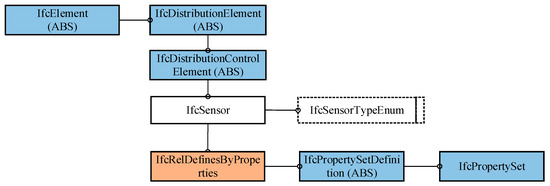
Figure 3.
EXPRESS-G diagram for monitoring information enrichment.
4.2.2. Information Extraction from BIM Models
In this paper, Dynamo programming is used to uniformly extract object attributes from a semantic-enriched BIM model, including both static and dynamic information. Dynamo is an open-source visual programming platform embedded in Autodesk Revit. Figure 4 shows a schematic diagram of Dynamo visual programming, and the basic components are nodes, lines, and connection points. Each node is designed to perform specific operations—for example, the Point.ByCoordinates node determines a point through the x, y, z coordinates, applying a connection relationship between different nodes through lines and connection points, and it then uses the Line.ByStartPointandEndPoint node to connect two points and form a line.

Figure 4.
Schematic diagram of Dynamo visual programming.
Applying Dynamo has the following advantages: (1) The abundant node libraries in Dynamo can provide solutions for different tasks and the visual programming form is friendly to engineers; (2) As an embedded plug-in of Autodesk Revit software, it can easily interact with the BIM models constructed; (3) It enjoys a function of automation and periodic operation, which is helpful in dynamically obtaining, supplementing, and updating information. Its advantages have been reflected in a variety of tasks. For example, Wang et al. used Dynamo to realize the automated virtual assembly of complex steel structures [41]. Alavi et al. applied Dynamo to obtain building condition information from the BIM model and visualize the evaluation results [42]. LLatas et al. used Dynamo programming to link to a database for real-time calculation and visualized validation of sustainability assessment during the building life cycle [43].
4.3. Multi-Information Fusion Method
The safety risk assessment of undersea tunnel construction projects is an MCDM process that needs both static and dynamic information. Thus, a multi-information fusion method is needed to integrate information from various sources for reasonable decisions. It consists of three main steps: (1) BPAs calculation, (2) information fusion under conflict, and (3) evidence update in a dynamic environment. The process of determining the contribution of different indicators to various safety risk levels enjoys fuzziness and hesitation because of the participation of domain experts. Thus, IFS theory and D-S evidence theory discussed in Section 3 are combined to meet the actual situation.
4.3.1. BPAs Calculation
The first step in using D-S evidence theory to fuse multi-source information is to determine the BPAs of different evidence under various criteria. IFS theory is applied to express the ambiguity and hesitation degree in the process of BPAs determination, with the BPAs represented by membership, non-membership, and hesitation degrees. Suppose there are hypotheses on the frame of discernment, and each hypothesis represents a safety risk level. With consideration of the actual situation in the real world, a hybrid intuitionistic fuzzy membership and non-membership function is constructed for the safety risk levels. The membership function and the non-membership function are given by Equations (9)–(11). When , the safety risk level can be represented by an IFV as , where is the lower bound, the most likely value, and the upper bound of the IFV, respectively, and represents the membership and non-membership degree when , respectively. Similarly, when , the safety risk level can be defined as , and when , the safety risk level can be described as . Suppose and the function image is as shown in Figure 5.
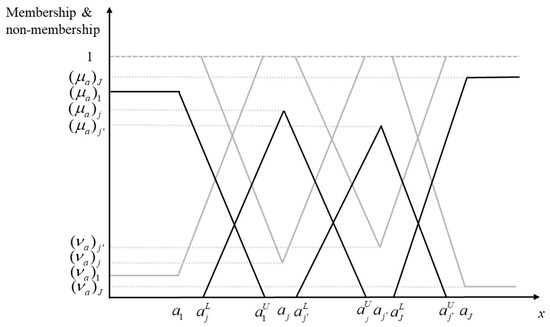
Figure 5.
Membership and non-membership function when .
.
When :
When :
When :
With the above definitions, the determination of the membership and non-membership function under different safety risk levels can be divided into two steps: (1) Risk grade recognition to decide intervals of each safety risk level; they are generally based on the literature, field experience, or experiments. (2) Uncertainty representation of the risk gradation process under limited knowledge. This is reflected by the affiliation relationship between and the safety risk level, . It is usually expressed in natural language by domain experts and can be quantified by the conversion rules shown in Table 3.

Table 3.
Conversion between linguistic variables and (after research [44]).
After the two steps, the IFVs of each safety risk level are determined. Using the constructed IFVs, the BPA of the indicator over the criteria can then be calculated by Equations (9)–(11) with a given crisp value and is represented as .
4.3.2. Information Fusion under Conflict
After the BPAs determination, Dempster’s rule in Equation (6) is used for multi-source information fusion, with each piece of evidence regarded as equally important in the calculation process. However, when the conflict coefficient is too large, applying Dempster’s rule for information fusion may obtain counter-intuitive results [45]. Following the previous works and based on the calculation rules of IFVs presented in Section 3.1, a modification rule is given in Equations (12)–(14), in order to identify highly supported evidence by similarity calculation under conflict and obtain more reasonable fusion results. Firstly, calculate the support degree of evidence by Equation (12):
where is the normalized Hamming distance between pairs of IFSs, with the formula defined in Equation (1).
The credibility of the evidence is then calculated with Equation (13):
Next, correct the BPAs of evidence using credibility given in Equation (14):
Finally, apply Dempster’s rule in Equation (6) for information fusion with the revised evidence. For pieces of evidence, the information fusion process is repeated times and the fusion result under conflict can be obtained.
4.3.3. Evidence Update in a Dynamic Environment
Tunnel construction is a complex dynamic process, and new information continuously acquired provides new evidence for decision-making. Taking previous safety risk assessment results as part of prior information in the subsequent decision-making process can obtain a more reasonable outcome [46]. Kulasekere et al. [47] proposed a conditional linear combination rule for BPAs updating, given by Equation (15):
where is a pair of arguments that depend on the conditional proposition and satisfies ; is the BPA of historical evidence over the event ; is the BPA to the event , under the condition that the current evidence fully supports the event ; is the BPA of the event under the condition of the previously occurred event ; and can be calculated with Equation (16):
Extending Equation (15) to the time dimension, we obtain:
where represents the BPA of time after updating; and satisfies , representing the weight of the previous moments and the moment , respectively; and and are events on the frame of discernment, among which event is the one with the highest confidence.
Equations (12) and (13) are then used to calculate the credibility of evidence and determine the value of , where . It should be noted that, different to the method mentioned in Section 4.3.2, the information fusion result at the moment is regarded as a piece of evidence, and thus the current fusion result is updated by calculating the support degree of the previous fusion results to the current status.
4.4. Safety Risk Perception
Safety risk perception aims to achieve a safety risk level based on the multi-information fusion results obtained and helps risk managers take proper control measures for risk prevention. According to the calculation rules of IFVs, the BPAs obtained after information fusion are also IFVs. They are represented as and can be converted into crisp values using the intuitionistic fuzzy score function presented in Equation (2). The score function values are then ranked under different safety risk levels, with the maximum score function value corresponding to the current safety risk level.
The tunnel collapse risk is divided into four decision levels based on the relevant literature [1,24,34,35]. With safety risk levels obtained and updated through the construction process, Dynamo programming is used to enhance safety risk perception in a visualization form, reflecting the tunnel condition of the physical world in a BIM environment. The color representations in the BIM model corresponding to the four safety risk levels are shown in Table 4.

Table 4.
Color representations for different safety risk levels.
Under the four safety risk levels, tunnel construction managers can implement different control measures, as shown in Table 5.

Table 5.
Control measures under different safety risk levels.
5. Case Study
5.1. Backgrounds
The shield tunnel in the case study is a metro tunnel in Dalian, China. The total length of the tunnel is 3310 m, of which 2310 m crosses the sea and the rest traverses the land, as shown in Figure 6. The research object of this case study is the sea-crossing section of the shield tunnel. It crosses the sea with a water depth of 4~9 m, with the maximum excavation depth 49 m below sea level. It is a large-diameter tunnel with inner and outer diameters of 10.8 m and 11.8 m, respectively. According to geological survey reports, the tunnel passes through three major karst development areas, as shown in Figure 7. Since the existence of the karst caves is a severe threat to tunnel construction, the locations, scales, and fillers of the karst caves have been specially investigated. A total of 172 caves were counted, with an average cave height of 2.35 m. Among them, there are 133 fully filled karst caves, accounting for 77.3% of the total caves, with an average cave height of 2.5 m; 12 semi-filled karst caves, accounting for 7% of the total caves, with an average cave height of 2.2 m; 27 unfilled karst caves, accounting for 15.7% of the total caves, with an average cave height of 1.8 m.
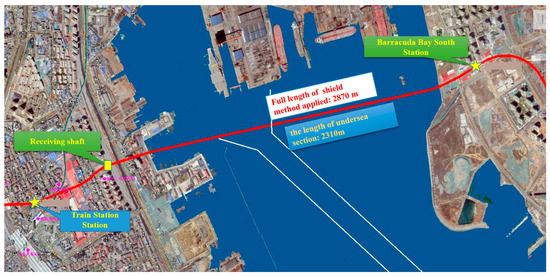
Figure 6.
The layout of the undersea metro tunnel in Dalian, China.

Figure 7.
Profile view of the undersea tunnel.
Monitoring and measurement activities are performed to grasp the dynamic condition of the site environment and structural status during tunnel construction. The main monitoring items include surface settlement, segment stress, clearance convergence, vault settlement, and horizontal displacement. The monitoring points of clearance convergence, vault settlement, and horizontal displacement are arranged in the same monitoring cross-section, with monitoring cross-sections distributed every 10 rings. Segment stress monitoring cross-sections are distributed every 50 rings, with four monitoring points arranged for each cross-section. Among them, two monitoring points are for axial stress and the others are laid out for hoop stress. A MySQL relational database is used to store monitoring data.
The tunnel collapse risk of tunnel construction in the karst development area is the focus of this case study. Pre-treatment measures such as targeted grouting reinforcement are performed on the karst caves before construction to reduce the probability of risk accidents occurrence caused by unfavorable geological conditions. Safety risk assessments are then performed using information before and after the karst cave treatment, with the treatment effect obtained by results comparison. With the supplement of monitoring information during construction, dynamic update and real-time grasp of the safety risk level is further conducted.
5.2. Membership and Non-Membership Function Determination
According to the membership and non-membership function construction steps in Section 4.3.1, the IFVs of each index under different safety risk levels are determined by referring to the literature and field experience. The details are as follows:
Step 1: Risk grade recognition
- (1)
- For the indexes , the risk grade recognition of each index is determined by referring to the classification standards in the literature [16,18,35].
- (2)
- For the indexes , according to the Code for monitoring measurement of urban rail transit engineering in China, the control value of the deformation monitoring of segments should include the cumulative change value and the change rate [39]. According to the specifications and field experience, for the tunnel construction project in the case study, the cumulative change control value for vault settlement and clearance convergence is 20 mm and 24 mm, and the control change rate is 2 mm/d and 3 mm/d, respectively. Since the monitoring frequency is set as 1 day, the daily control values are 2 mm and 3 mm, respectively. The control value is taken as , with , and taking 80%, 50%, and 20% of the control value, respectively.
- (3)
- For the indexes , similar to the indexes , the stress monitoring control value should include the maximum and minimum values according to the Chinese national code [39]. According to engineering experience, in the case study, the maximum and minimum segment stress control values are set as 23.1 Mpa and −1.89 Mpa, respectively. The control value is taken as , with , and taking 80%, 50%, and 20% of the control value, respectively.
Step 2: Uncertainty representation
The uncertainty existing in the risk intervals’ determination of the first step is represented by inquiring domain experts. The affiliation relationships between and different safety risk levels are given by the domain experts in natural language as VL, L, M, H, and VH, and are then quantified by the conversion relationships shown in Table 3.
The IFVs of each index under different safety risk levels are summarized in Table 6.

Table 6.
IFVs of different indicators under four safety risk levels.
5.3. Semantic Enrichment of BIM Model and Information Extraction
A shield tunnel model is built using Autodesk Revit and Dynamo. The segments are created through adaptive families and Dynamo is used for the automatic assembly of the tunnel lining structure. The tunnel BIM model is shown in Figure 8.

Figure 8.
The constructed BIM model for the undersea tunnel project.
In this study, sensors are simplified and represented by cubes to locate the monitoring points in the BIM model. Following the extended IFC schema displayed in Table 2, the static monitoring information, including device type, sensor ID, monitoring content, and alarm threshold, is preset by adding shared parameters to the sensor family, as shown in Figure 9. Taking the segment stress sensor as an example, the upper limit of the alarm threshold is 23.1 Mpa and the lower limit is −1.89 Mpa. Dynamic parameters, including monitoring values and acquisition time, are supplemented to the sensor model by adding attribute values to instances.
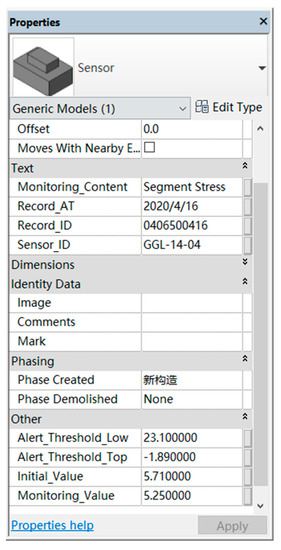
Figure 9.
Properties of the stress sensor in the BIM model.
The input of dynamic attribute values in the BIM model is realized through Dynamo programming and consists of three main steps, as follows:
- (1)
- Connect the BIM model to the MySQL relational database and acquire information.
Use the Connection.MySQL_ConnectionString node to establish a connection to the MySQL relational database. Next, connect the SQL.SelectFrom and Query.MySQL_Query nodes, set the database name and table name, and obtain the monitoring ID, monitoring time, and monitoring value in the table. The Dynamo nodes are shown in Figure 10.
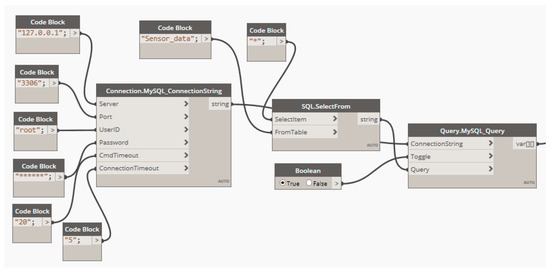
Figure 10.
Dynamo nodes of connecting BIM model to MySQL database.
- (2)
- Establish a unique relationship between monitoring ID in the BIM model and the MySQL database, and input the attribute values into the sensor model.
Firstly, use the Select Model Element and Element.GetParameterValueByName nodes to obtain the monitoring ID attribute of sensor instances and apply the List.Transpose, List.Deconstruct, and List.MaximumItem nodes to deal with information acquired from the database. Next, use the SafeIF node to judge and establish a unique corresponding relationship between sensor instances and monitoring information in the database. Finally, the dynamic monitoring information is added to sensor instances by Element.SetParameterByName node. The Dynamo nodes are shown in Figure 11.

Figure 11.
Dynamo nodes of writing information acquired to sensor attribute values.
- (3)
- Set the periodic running interval of Dynamo.
For this case study, the monitoring interval is set as one day based on codes, specifications, and field experience. Thus, the sensor monitoring data are inputs from the database into the BIM model once a day (acquiring the monitoring data at 15:00), with the periodic running interval of Dynamo set to 86,400,000 ms, as shown in Figure 12.

Figure 12.
Set Dynamo periodic run interval.
Through the above steps, the semantic enrichment of the BIM model to facilitate the MCDM process is realized. The Element.GetParameterValueByName node is used to extract the required information and export it to Excel through the Data.ExportExcel node, then information fusion for safety risk assessments can be performed. The Dynamo nodes are shown in Figure 13.
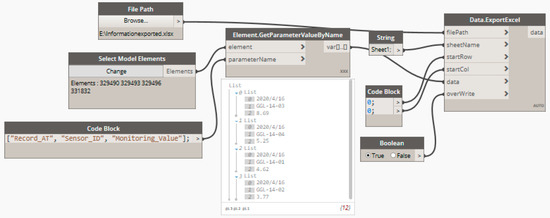
Figure 13.
Dynamo nodes of information export from BIM model to Excel file.
The K12 + 165~K12 + 215 section is an example of performing a safety risk assessment. The total length of this section is 50 m and there is one segment stress monitoring cross-section and two deformation monitoring cross-sections. Part of the information extracted from the BIM model is shown in Table 7. After treatment conducted in the karst development area, the percentage of boreholes in which karst is encountered and the maximum karst cave height values have reduced. The monitoring data of dynamic segment stress and part of the deformation value of 20 days during construction are illustrated in Figure 14.

Table 7.
Evidence information extracted from the BIM model.
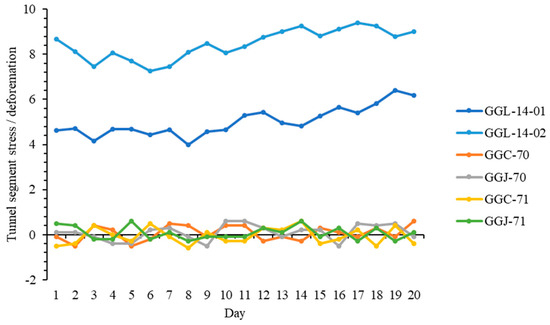
Figure 14.
Extracted dynamic evidence information from the BIM model. (Note: GGL-14-01 and GGL-14-02 represent the segment stress values of the first and second monitoring points of the 14th stress monitoring cross-section, respectively. GGC-70 and GGC-71 represent the daily vault settlement values of the 70th and 71st deformation monitoring cross-sections, respectively. GGJ-70 and GGJ-71 represent the daily clearance convergence values of the 70th and 71st deformation monitoring cross-sections, respectively).
5.4. Information Fusion and Safety Risk Perception
To perform information fusion, firstly, Equations (9)–(11) are used to calculate the BPAs of each indicator, with the results presented in Table 8.

Table 8.
BPAs of influential factors before construction.
Equations (12) and (13) are then used to calculate the weight of each piece of evidence before and after the treatment of karst-developed geological conditions, with the results as follows:
Before treatment: .
After treatment: .
Finally, the fusion results are gained with Equations (6) and (14). The BPAs of different safety risk levels are ranked according to the score function of IFVs in Equation (2), with the results > > > before treatment and > > > after treatment. The results are shown in Table 9.

Table 9.
Fusion results before and after treatment of karst development area.
It can be seen that the safety risk level of the karst development area before treatment is level IV, which means that there is a high probability of collapse. Thus, the construction procedures and design parameters should be checked, and professional treatments should be conducted at karst caves. After treatment measures are taken, the safety risk is reduced to level I, which means that no more control measures are required and construction tasks can be performed.
However, although treatment measures have been conducted in the karst developed area, the shield tunneling and grouting factors may still affect the safety risk status of the undersea tunnel. Therefore, by analyzing the dynamic segment stress and deformation monitoring data during the construction process, attention is continually paid to the real-time safety risks. Table 10 shows the BPAs of stress and deformation monitoring evidence on Day 1.

Table 10.
BPAs of influential factors during construction on Day 1.
Dynamic information fusion is performed by Equations (15)–(17). Suppose , then take the fusion results obtained in the first three monitoring days as the initial evidence and dynamically update them from the fourth monitoring day. Table 11 shows the tunnel status is stable at the safety risk level I within the 20-day research range, and no more control measures are required.

Table 11.
Dynamic fusion results before and after update.
The safety risk assessment results of different stages are visualized in the BIM model and shown in Figure 15.

Figure 15.
Safety risk levels visualization in BIM model.
6. Discussion
This paper developed a novel approach integrating BIM, IFS theory, and D-S evidence theory to deal with the undersea tunnel construction safety risk management under a dynamic, fuzzy, and uncertain environment. BIM is used for the uniform acquisition of both spatial and temporal information during decision-making and visualization for safety risk perception. IFS theory is applied to meet the fuzziness situation by applying D-S evidence theory in multi-source information fusion. The conflicting evidence is taken into consideration by the normalized Hamming distance between pairs of IFSs. The validation of the results and discussion of the proposed method in enhancing decision-making are described below from both practical and theoretical points of view.
- (1)
- The practical point of view
By applying the method approach to collapse risk assessment of the case study project, we can determine that the safety risk level before treatment of the unfavorable geological condition is at level IV, which means that there is a high probability of collapse that must be dealt with according to the risk control measures shown in Table 5. Methods of pre-treatment before construction, control during shield tunneling, and post-treatment after construction are adopted to deal with karst caves. A special geological survey was conducted within 3m on both sides of the tunnel and within 10 m below the bottom of the cave to find out the distributions, scales, and fillings of the karst caves. Karst caves are classified as unfilled, semi-filled, and fully filled to perform distinguished treatment measures. For large karst caves above 4m, the principle of “one cave, one measure” treatment is followed; the bead-shaped karst caves are treated from bottom to top; the method of “stop slurry on both sides and internal filling” is adopted for the strata with dissolution developed. After treatment, the safety risk level is reduced to level I, which indicates the effectiveness of karst cave grouting in advance.
During the construction process, abnormal excavation parameters are monitored in real time, with measures taken in time to avoid accidents. By integrating the dynamic segment stress and deformation monitoring data of different monitoring cross-sections, the obtained safety risk level during the 20 monitoring days studied has been maintained at level I, which indicates a safe construction process. Through the scientific and effective treatment of the karst strata, a safe and smooth shield tunnel construction process is ensured. BIM-based information acquisition ensured the quantity and quality of information for the decision-making process, while the dynamic visualization of safety risk levels helped risk managers to capture safety risk conditions more directly and efficiently.
- (2)
- The theoretical point of view
The theoretical contribution of this study lies in the combination of IFS theory and D-S evidence theory to enhance the decision-making process by improving the expression of fuzziness and hesitation. It is mainly reflected in the use of IFVs to determine BPAs and the use of the normalized Hamming distance between pairs of IFSs to calculate the support degree of evidence and deal with conflicts between evidence. To reflect the advantages of the proposed method from the theoretical point of view, the result is compared with that of Zhang and Ma’s method from the literature review, respectively. Zhang used the FME theory for BPAs calculation when applying D-S evidence theory [16]. Ma applied triangular fuzzy numbers (TFNs) to construct the target model and generate BPAs [23]. FME theory can solve the problem of fuzzy membership between points and intervals, with the formula of FME theory used to calculate BPAs under different safety risk levels given by Equation (18). In Ma’s method, the membership function of TFNs is shown in Equation (19). Specifically, in the background to this article, and, thus, only a regular triangular fuzzy number is applied.
The fusion results are obtained using the information before and after treatment of the karst developed area in Table 7, with a comparison of Zhang’s method, Ma’s method, and the proposed method shown in Table 12. The absolute value of variance between the maximum and minimum fusion results of the three methods is also calculated.

Table 12.
Fusion results before and after treatment based on the three methods.
The safety risk assessment results obtained using FME and triangular fuzzy set (TFS) theory for BPAs determination are consistent with that of IFS theory proposed in this paper. Figure 16 compares the results under different safety risk levels based on the three methods. In Figure 16, BT and AT are the abbreviations for before treatment and after treatment, respectively. The safety risk levels of the karst development area before and after treatment are both at levels IV and I, which shows the effectiveness of the method proposed in this paper.
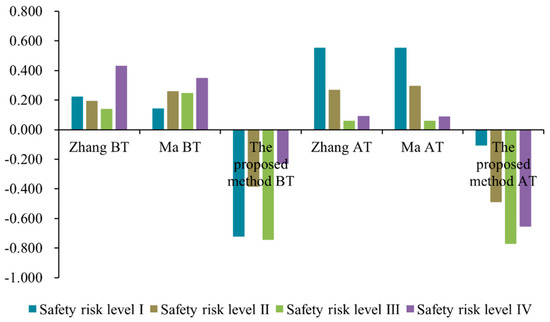
Figure 16.
Comparison of fusion results using the three methods.
Based on the comparison of variance results shown in Table 12, the largest change in the maximum and minimum values of safety risk levels is a result of the proposed method, which means that it is easier to judge the belonging between two adjacent safety risk levels. Furthermore, the proposed method for determining BPAs based on IFS theory takes expert opinions into account in the process of applying D-S evidence theory. Compared with Zhang’s method, it is more suitable for situations where there is a lack of data and expert experience is needed to determine the boundaries of different risk levels. The method based on the TFS theory proposed by Ma cannot express the hesitation degree of experts in the case of insufficient information or lack of knowledge, which often happens during decision-making, and thus IFS theory is more applicable to the actual situation. However, it must be pointed out that Ma used sample data to establish the membership function of TFNs, while the on-site differential data collected from undersea tunnel construction projects are often limited and cannot be assigned to all safety risk levels. Thus, the construction of membership and non-membership functions largely depends on the subjective opinions of experts, which is one insufficiency of this paper.
7. Conclusions and Future Works
Safety risk assessment of undersea tunnel construction projects is a tricky issue that needs to acquire and integrate multi-information from various sources for reasonable decision-making and risk perception. This paper proposed a new method based on BIM and intuitionistic fuzzy D-S evidence theory for undersea tunnel construction safety risk assessment. A safety risk evaluation index system for both the pre-construction and construction stages, considering geological conditions and construction factors, is proposed. Geological inspection reports and design information are used as evidence before construction, while dynamic segment stress and deformation monitoring data are applied for safety risk assessment during construction. BIM is used to dynamically acquire, integrate, and provide the multi-information required for the fusion process. IFS theory is applied to represent fuzziness and hesitation, with membership and non-membership degrees used for BPAs determination. The weight of evidence is then calculated by mutual support degree, with information fusion in the conflict and dynamic environment performed based on the IFVs’ calculation rules and D-S evidence theory. Finally, the score function of IFVs is applied to derive safety risk levels from fusion results, with BIM visualization used for safety risk perception.
The proposed method was applied to a shield undersea tunnel construction project. The safety risk level before and after the treatment of the karst development area was reduced from level IV to level I, indicating the effectiveness of karst caves pre-processing. During the construction process, the segment stress and deformation monitoring data were dynamically obtained, the safety risk assessment was conducted in real time, and the safety risk was stabilized at level I. The obtained results are then compared with methods of other studies and validated from both practical and theoretical points of view. The proposed method can also be applied to other shield tunnel construction projects.
The proposed approach has the following theoretical and managerial implications: (1) the knowledge gap of the structured expression of tunnel safety risk assessment dynamic information in the BIM model is bridged through IFC extension, and a uniform information acquisition mean is provided by Dynamo programming; (2) the fuzziness and hesitation during BPAs determination are quantified with IFS theory, and the conflict of evidence is taken into consideration with the normalized Hamming distance between IFSs, which brings a view for more reasonable usage of D-S evidence theory in the actual world; (3) multi-information of both static and dynamic sources can be effectively used to obtain a more comprehensive understanding of shield tunnel construction safety risks conditions; (4) with the assistance of BIM technology, the dynamic safety risk level of shield tunnel construction projects is obtained in a visual form for better risk perception.
Limitations exist with the proposed approach. When conducting basic probability assignments based on IFS theory, the determination of the boundaries of each criterion is a subjective and, thus, tricky task. Limited by field data, the construction of membership and non-membership functions in this paper is based on the related literature and expert experience. In follow-up research, data can be collected through experiments or simulations and therefore the volume will be enriched. Moreover, although expert opinion has been taken into consideration during BPAs determination, it is not used as a source of evidence. Such evidence is also indispensable and needs to be added to future studies’ safety risk assessment processes to improve results’ accuracy by supplementing information sources.
Author Contributions
Conceptualization, X.X.; methodology, X.X.; formal analysis, X.X.; investigation, J.Z.; resources, J.Z.; writing—original draft preparation, X.X.; writing—review and editing, Y.Y. and J.Z.; visualization, X.X.; supervision, Y.Y.; project administration, Y.Y. All authors have read and agreed to the published version of the manuscript.
Funding
This research received no external funding.
Data Availability Statement
The data presented in this study are available on request from the corresponding author.
Conflicts of Interest
The authors declare no conflict of interest.
References
- Li, L.; Lei, T.; Li, S.; Zhang, Q.; Xu, Z.; Shi, S.; Zhou, Z. Risk assessment of water inrush in karst tunnels and software development. Arab. J. Geosci. 2015, 8, 1843–1854. [Google Scholar] [CrossRef]
- Zhou, H.; Zhao, Y.; Shen, Q.; Yang, L.; Cai, H. Risk assessment and management via multi-source information fusion for undersea tunnel construction. Autom. Constr. 2020, 111, 103050. [Google Scholar] [CrossRef]
- Cai, Q.; Hu, Q.; Ma, G. Improved Hybrid Reasoning Approach to Safety Risk Perception under Uncertainty for Mountain Tunnel Construction. J. Constr. Eng. Manag. 2021, 147, 04021105. [Google Scholar] [CrossRef]
- Ou, G.-Z.; Jiao, Y.-Y.; Zhang, G.-H.; Zou, J.-P.; Tan, F.; Zhang, W.-S. Collapse risk assessment of deep-buried tunnel during construction and its application. Tunn. Undergr. Space Technol. 2021, 115, 104019. [Google Scholar] [CrossRef]
- Koch, C.; Vonthron, A.; König, M. A tunnel information modelling framework to support management, simulations and visualisations in mechanised tunnelling projects. Autom. Constr. 2017, 83, 78–90. [Google Scholar] [CrossRef]
- Alshboul, O.; Shehadeh, A.; Hamedat, O. Governmental Investment Impacts on the Construction Sector Considering the Liquidity Trap. J. Manag. Eng. 2022, 38, 04021099. [Google Scholar] [CrossRef]
- Chen, K.; Lu, W. Bridging BIM and building (BBB) for information management in construction. Eng. Constr. Arch. Manag. 2019, 26, 1518–1532. [Google Scholar] [CrossRef]
- Zou, Y.; Kiviniemi, A.; Jones, S.W. A review of risk management through BIM and BIM-related technologies. Saf. Sci. 2017, 97, 88–98. [Google Scholar] [CrossRef]
- Tan, T.; Mills, G.; Papadonikolaki, E.; Liu, Z. Combining multi-criteria decision making (MCDM) methods with building information modelling (BIM): A review. Autom. Constr. 2021, 121, 103451. [Google Scholar] [CrossRef]
- Lee, P.-C.; Lo, T.-P.; Tian, M.-Y.; Long, D. An Efficient Design Support System based on Automatic Rule Checking and Case-based Reasoning. KSCE J. Civ. Eng. 2019, 23, 1952–1962. [Google Scholar] [CrossRef]
- Ding, Z.; Niu, J.; Liu, S.; Wu, H.; Zuo, J. An approach integrating geographic information system and building information modelling to assess the building health of commercial buildings. J. Clean. Prod. 2020, 257, 120532. [Google Scholar] [CrossRef]
- Zhang, H. Design and Implementation of BIM-based Fire Risk Assessment System. J. Physics Conf. Ser. 2020, 1584, 012064. [Google Scholar] [CrossRef]
- Figueiredo, K.; Pierott, R.; Hammad, A.W.; Haddad, A. Sustainable material choice for construction projects: A Life Cycle Sustainability Assessment framework based on BIM and Fuzzy-AHP. Build. Environ. 2021, 196, 107805. [Google Scholar] [CrossRef]
- Fazeli, A.; Jalaei, F.; Khanzadi, M.; Banihashemi, S. BIM-integrated TOPSIS-Fuzzy framework to optimize selection of sustainable building components. Int. J. Constr. Manag. 2019, 22, 1240–1259. [Google Scholar] [CrossRef]
- Caterino, N.; Nuzzo, I.; Ianniello, A.; Varchetta, G.; Cosenza, E. A BIM-based decision-making framework for optimal seismic retrofit of existing buildings. Eng. Struct. 2021, 242, 112544. [Google Scholar] [CrossRef]
- Zhang, L.; Ding, L.; Wu, X.; Skibniewski, M.J. An improved Dempster–Shafer approach to construction safety risk perception. Know. Based Syst. 2017, 132, 30–46. [Google Scholar] [CrossRef]
- Bhalla, S.; Yang, Y.W.; Zhao, J.; Soh, C.K. Structural health monitoring of underground facilities—Technological issues and challenges. Tunn. Undergr. Space Technol. 2005, 20, 487–500. [Google Scholar] [CrossRef]
- Guo, K.; Zhang, L. Multi-source information fusion for safety risk assessment in underground tunnels. Know. Based Syst. 2021, 227, 107210. [Google Scholar] [CrossRef]
- Zhao, K.; Li, L.; Chen, Z.; Sun, R.; Yuan, G.; Li, J. A survey: Optimization and applications of evidence fusion algorithm based on Dempster–Shafer theory. Appl. Soft Comput. 2022, 124, 109075. [Google Scholar] [CrossRef]
- Yang, J.-B.; Xu, D.-L. On the evidential reasoning algorithm for multiple attribute decision analysis under uncertainty. IEEE Trans. Syst. Man Cybern. Part A Syst. Hum. 2002, 32, 289–304. [Google Scholar] [CrossRef]
- Zhang, L.; Wu, X.; Zhu, H.; AbouRizk, S.M. Perceiving safety risk of buildings adjacent to tunneling excavation: An information fusion approach. Autom. Constr. 2017, 73, 88–101. [Google Scholar] [CrossRef]
- Ding, H.; Hou, R.; Ding, X. A data fusion equipment monitoring method based on fuzzy set and improved D-S evidence theory. In Proceedings of the International Conference on Natural Computation, Fuzzy Systems and Knowledge Discovery (ICNC-FSKD), Guilin, China, 25 June 2017; pp. 1070–1076. [Google Scholar] [CrossRef]
- Ma, T.; Xiao, F. An Improved Method to Transform Triangular Fuzzy Number into Basic Belief Assignment in Evidence Theory. IEEE Access 2019, 7, 25308–25322. [Google Scholar] [CrossRef]
- Xia, Y.; Xiong, Z.; Lu, H.; Wen, Z.; Ma, C. Fuzzy risk assessment of a deeply buried tunnel under incomplete information. R. Soc. Open Sci. 2018, 5, 180305. [Google Scholar] [CrossRef] [PubMed]
- Xu, Z.; Zhao, N. Information fusion for intuitionistic fuzzy decision making: An overview. Inf. Fusion 2016, 28, 10–23. [Google Scholar] [CrossRef]
- Murphy, C.K. Combining belief functions when evidence conflicts. Decis. Support Syst. 2000, 29, 1–9. [Google Scholar] [CrossRef]
- Xiao, F. Multi-sensor data fusion based on the belief divergence measure of evidences and the belief entropy. Inf. Fusion 2019, 46, 23–32. [Google Scholar] [CrossRef]
- Atanassov, K. Intuitionistic fuzzy sets. Fuzzy Sets Syst. 1986, 20, 87–96. [Google Scholar] [CrossRef]
- Zhang, X.; Xu, Z. A new method for ranking intuitionistic fuzzy values and its application in multi-attribute decision making. Fuzzy Optim. Decis. Mak. 2012, 11, 135–146. [Google Scholar] [CrossRef]
- Szmidt, E.; Kacprzyk, J. Distances between intuitionistic fuzzy sets. Fuzzy Sets Syst. 2000, 114, 505–518. [Google Scholar] [CrossRef]
- Lin, L.; Yuan, X.-H.; Xia, Z.-Q. Multicriteria fuzzy decision-making methods based on intuitionistic fuzzy sets. J. Comput. Syst. Sci. 2007, 73, 84–88. [Google Scholar] [CrossRef]
- Dempster, A.P. Upper and Lower Probabilities Induced by a Multivalued Mapping. Ann. Math. Stat. 1967, 38, 325–339. [Google Scholar] [CrossRef]
- Inglis, J. A Mathematical Theory of Evidence. Technometrics 1978, 20, 106. [Google Scholar] [CrossRef]
- Wang, X.; Li, S.; Xu, Z.; Li, X.; Lin, P.; Lin, C. An interval risk assessment method and management of water inflow and inrush in course of karst tunnel excavation. Tunn. Undergr. Space Technol. 2019, 92, 103033. [Google Scholar] [CrossRef]
- Zhang, K.; Zheng, W.; Liao, Z.; Xie, H.; Zhou, C.; Chen, S.; Zhu, J. Risk assessment of ground collapse along tunnels in karst terrain by using an improved extension evaluation method. Tunn. Undergr. Space Technol. 2022, 129, 104669. [Google Scholar] [CrossRef]
- Cui, Q.-L.; Wu, H.-N.; Shen, S.-L.; Xu, Y.-S.; Ye, G.-L. Chinese karst geology and measures to prevent geohazards during shield tunnelling in karst region with caves. Nat. Hazards 2015, 77, 129–152. [Google Scholar] [CrossRef]
- Ministry of Housing and Urban-Rural Development of the People’s Republic of China. Code for Design of Building Foundation; Ministry of Housing and Urban-Rural Development of the People’s Republic of China: Beijing, China, 2012.
- Deere, D.U.; Hendron, A.J.; Patton, F.D.; Cording, E.J. Design of Surface And Near-Surface Construction in Rock. In Proceedings of the 8th US Symposium of Rock Mechanics, Minneapolis, MN, USA, 15–17 September 1966. [Google Scholar]
- Ministry of Housing and Urban-Rural Development of the People’s Republic of China. Code for Monitoring Measurement of Urban Rail Transit Engineering; Ministry of Housing and Urban-Rural Development of the People’s Republic of China: Beijing, China, 2013.
- Ding, L.; Li, K.; Zhou, Y.; Love, P.E. An IFC-inspection process model for infrastructure projects: Enabling real-time quality monitoring and control. Autom. Constr. 2017, 84, 96–110. [Google Scholar] [CrossRef]
- Wang, Y.-G.; He, X.-J.; He, J.; Fan, C. Virtual trial assembly of steel structure based on BIM platform. Autom. Constr. 2022, 141, 104395. [Google Scholar] [CrossRef]
- Alavi, H.; Bortolini, R.; Forcada, N. BIM-based decision support for building condition assessment. Autom. Constr. 2022, 135, 104117. [Google Scholar] [CrossRef]
- Llatas, C.; Soust-Verdaguer, B.; Hollberg, A.; Palumbo, E.; Quiñones, R. BIM-based LCSA application in early design stages using IFC. Autom. Constr. 2022, 138, 104259. [Google Scholar] [CrossRef]
- Jing, L.; Yao, J.; Gao, F.; Li, J.; Peng, X.; Jiang, S. A rough set-based interval-valued intuitionistic fuzzy conceptual design decision approach with considering diverse customer preference distribution. Adv. Eng. Inform. 2021, 48, 101284. [Google Scholar] [CrossRef]
- Zadeh, L.A. On the Validity of Dempster’s Rule of Combinatio; Memo M 79/24; University of California: Berkeley, CA, USA, 1979. [Google Scholar]
- Xu, X.B.; Zhang, Z.; Li, S.B.; Wen, C.L. Fault diagnosis based on fusion and updating of diagnosis evidence. Acta Autom. Sin. 2016, 42, 107–121. [Google Scholar] [CrossRef]
- Kulasekere, E.; Premaratne, K.; Dewasurendra, D.; Shyu, M.-L.; Bauer, P. Conditioning and updating evidence. Int. J. Approx. Reason. 2004, 36, 75–108. [Google Scholar] [CrossRef]
Publisher’s Note: MDPI stays neutral with regard to jurisdictional claims in published maps and institutional affiliations. |
© 2022 by the authors. Licensee MDPI, Basel, Switzerland. This article is an open access article distributed under the terms and conditions of the Creative Commons Attribution (CC BY) license (https://creativecommons.org/licenses/by/4.0/).



